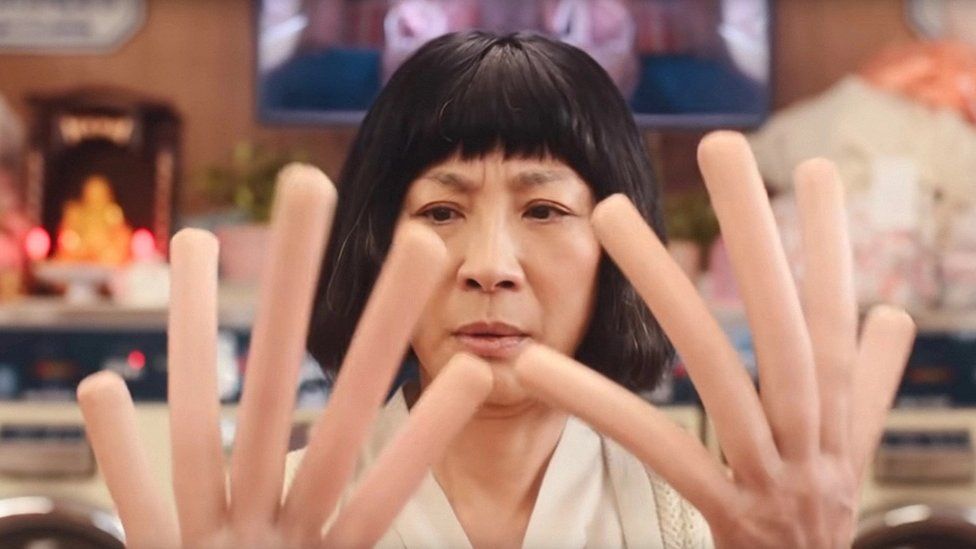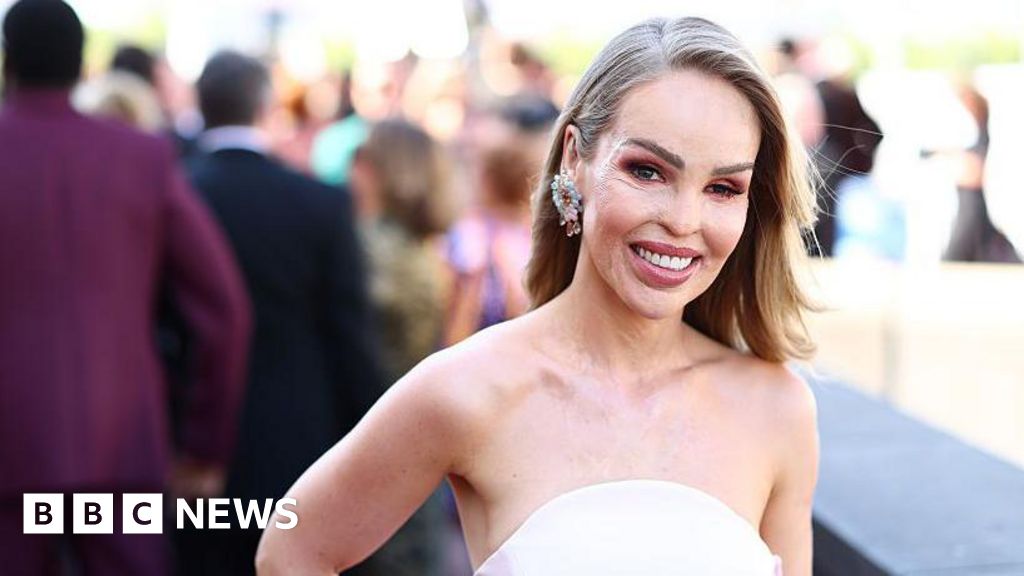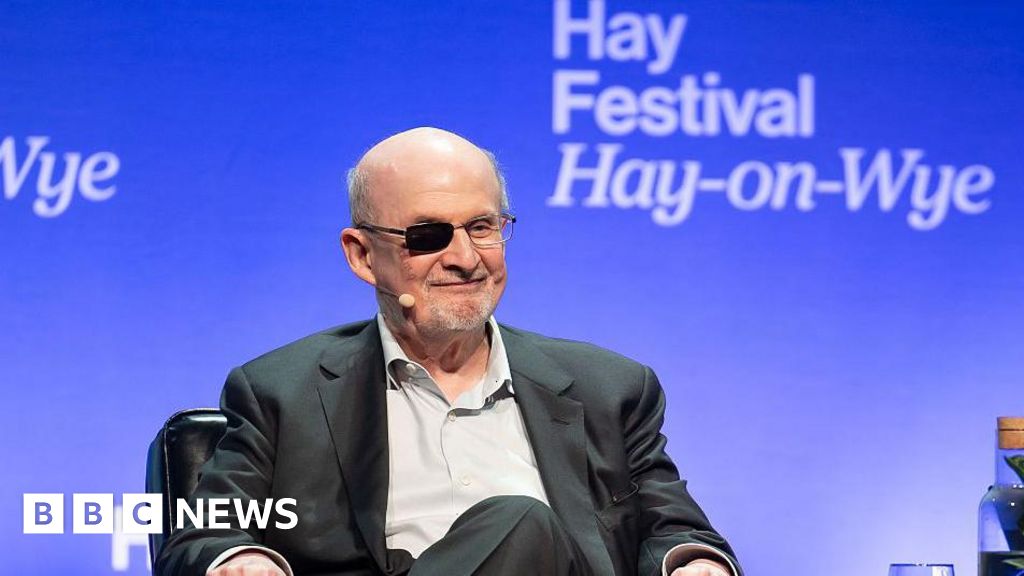ARTICLE AD BOX
 Image source, A24
Image source, A24
Michelle Yeoh in Everything Everywhere All At Once
By Mark Savage
BBC Music Correspondent
At first glance, Everything Everywhere All At Once is not a typical Oscar-winning movie.
A wildly inventive, universe-jumping story about getting your taxes filed, it features characters with hot dogs for hands, a nihilistic bagel, and a fight scene centred around a sex toy.
Despite (or perhaps because of) the absurd premise, the film has been the darling of awards season, culminating in its seven-Oscar haul on Sunday night.
Not only did it pick up best picture, but it won three of the four acting awards, as well as best original screenplay and best director for Daniel Kwan and Daniel Scheinert.
After that triumph, many people will be inspired to watch the film for the first time... and, on first viewing, there's a lot to digest.
So here's a handy guide to the main points and, for those of you who cueing it up for a second time, the Easter eggs you might have missed first time around.
The plot in a nutshell
Evelyn (Michelle Yeoh) is navigating an existential crisis.
A Chinese-American immigrant, her business, marriage and relationships are simultaneously crumbling. To distract herself, she dreams of the different paths her life could have taken if she wasn't married to eternal optimist Waymond (Ke Huy Quan) and constantly locking horns with her daughter Joy (Stephanie Hsu, pictured).
But when she visits the tax office, things get weird.
An alternative universe version of Waymond suddenly appears, informing Evelyn that all of existence is being threatened by an agent of chaos known as Jobu Tupaki - who also happens to be her daughter.
To defeat her, Evelyn must harness the power of multiple parallel-universe Evelyns, absorbing their skills in everything from martial arts to opera singing.
There are multiple callbacks to Michelle Yeoh's career
Image source, Getty Images
Yeoh, who was born in Malaysia, got her big break as a stunt actress, regularly appearing alongside Jackie Chan in the 1980s.
When her character needs to assimilate martial arts skills in Everything Everywhere All At Once, she taps into a movie star version of Evelyn, whose career is based on Yeoh herself.
The film even utilizes footage from the actress's public appearances, including a red carpet shot from the premiere of Crazy Rich Asians, and other archival shots from her career.
And that's not the only movie reference...
"This movie is one hundred percent a response to The Matrix, obviously," Daniel Kwan said at the South by Southwest festival, where the film premiered. "We wanted to make our version of it."
Like the Keanu Reeves classic, Everything Everywhere features a protagonist who finds out the world isn't quite what it seems, and who "downloads" new skills to defeat dark forces.
But the film references don't end there. A parody of 2001: A Space Odyssey's "discovery of tools" sequence involves a group of apes fighting to their death - except on this occasion they have hot dogs for fingers. (Fun fact: Director Daniel Scheinert plays almost all of the apes because they could only afford two costumes).
A fight scene in which the security guards appear in outlandish flamenco costumes is a nod to Jim Carrey's The Mask; and a romantic alleyway encounter between Yeoh and Quan is a visual homage to visionary director Wong Kar-Wai's moody, pensive dramas.
The scene carried extra resonance for Quan, who worked as an assistant director for the auteur in the years he struggled to find work as an actor.
The Daniels have hinted that there are even more hat-tips to their favourite movies, from Todd Haynes' Carol and Paul Thomas Anderson's Magnolia to the sci-fi classic The Repo Man. And there are further references to martial arts classics like Clan of the White Lotus and Executioners From Shaolin.
The movie draws on an Eastern storytelling form called Kishōtenketsu
Image source, Studio Ghibli
Most closely associated with Japan, but also present in China and Korea, Kishōtenketsu is a narrative structure characterised by self-realisation, understanding, and then change.
Unlike the "hero's journey" style employed by most Western movies, it doesn't rely on tropes of conflict and victory. Instead, it's divided into four distinct acts.
- kiku (ki): Introduction
- shōku (shō): Development
- tenku (ten): Twist
- kekku (ketsu): Conclusion
While writing, the Daniels took inspiration from the classic Japanese animation Princess Monokoke.
"I was obsessed with Princess Mononoke for the longest time," director Daniel Scheinert told Gizmodo.
"The finale is way more complicated than good vs. evil… There's not a bunch of bad guys that need to be murdered. Mononoke is much more morally ambiguous.
"They're trying to negotiate peace as a climax to a fantasy film, which is how we steered our film. "
The visual effects were created by a team of five people
Warning: Third party content may contain adverts
Most Hollywood films employ hundreds of animators and visual effects gurus. But with a budget of just $20m, the Daniels took a more home-spun approach.
Using free software and working from their bedrooms during the pandemic, a team of five people created more than 500 eye-popping visuals.
"Any shot that you've seen in this film, there's no price point on it that's particularly high," animator Ben Brewer told the BBC.
The Ratatouille scenes are more than a throwaway gag
Early in the movie, Evelyn mistakenly refers to the classic Pixar animation Ratatouille as "Racacoonie".
In case you've forgotten, the 2007 Brad Bird film centres on a hapless young chef, Remy, who befriends a talking rat with aspirations of becoming a high-end French chef. Somehow, the rat proves capable of controlling Remy's movements while hiding under his chef's hat, and the duo become the talk of Paris.
Evelyn's gaffe seems like a simple slip of the tongue... Until we see an alternate universe where her chef friend Chad has his limbs operated, marionette-style, by a raccoon.
The scene hints that "real" Evelyn is subconsciously aware of the other universes before she learns of their existence...
To add another layer, Ratatouille serves as a metaphor for the way in which Evelyn can be controlled by her other selves.
The central message is about the importance of kindness
Despite all the inter-dimensional weirdness, there's a genuine emotional pay-off to Everything Everywhere All At Once.
In the film, the existence of a multiverse turns Evelyn and Joy into nihilists. If anything is possible, then nothing matters.
Waymond, however, has his glass half-full.
In the third act of the film, he explains his philosophy to Evelyn: "When I choose to see the good side of things, I'm not being naive. It is strategic and necessary.
"It's how I've learned to survive through everything. I know you see yourself as a fighter. Well, I see myself as one too. This is how I fight."
Interestingly, that line seems to have been adapted from a quote that director Daniel Kwan retweeted in 2018.
It originally read: "Only fools think empathy is agreement. Empathy is both humane and strategic; it is morally wise and practically necessary."
Pay attention to the bagel
Image source, A24
Image caption,A menacing bagel is one of Everything Everywhere's most memorable metaphors
Resting at the very heart of the movie is Jobu Tupaki's Everything Bagel - a bagel that's been sprinkled with the dust of every event in every universe in every version of history.
"All my hopes and dreams, my old report cards, every breed of dog, every last personal ad on Craigslist, sesame, poppy seed, salt, and it collapsed in on itself," she explains.
The menacing circular bread roll is a motif for despair that occurs throughout the film: It's in the black felt tip ring that Evelyn scrawls on her tax returns; it's in the doors of the washing machines in her laundry; and it's burned into the forehead of Jobu's followers.
The bagel's nihilism is balanced by a series of googly eyes that Waymond habitually places on objects around the laundromat. They're the yin to the bagel's yang, a statement that it's still possible to be optimistic and find joy when the universe is in chaos.
At first, Evelyn dismisses her husband's frivolity, tutting as she removes the eyes from around her workplace. But when she reaches the height of her powers,, she deliberately places one on her forehead - an explicit reference to the spiritual tradition of the "enlightened" third eye.
The contrast between the black hole of the bagel and the white circle of the eye represents how darkness and light must work in unison.
The real reason that everything happens all at once
Image source, Getty Images
"Every time I set out to do a movie I have this fear that I'm gonna die," Daniel Kwan told Empire.
"Even when we were really young, we were like: 'This might be the last thing anyone ever lets us make! We better put everything into it!'
"The threshold for 'everything' has slowly grown to the point where we made this movie."
In an interview with the LA Times, Kwan added that the film's frenetic pace was a product of the "contradictions and emotional whiplash" of online discourse.
"The internet had started to create these alternate universes," said Kwan. "We were for the first time realising how scary the internet was, moving from this techno optimism to this techno terror.
"I think this movie was us trying to grapple with that chaos."

 2 years ago
66
2 years ago
66








 English (US) ·
English (US) ·